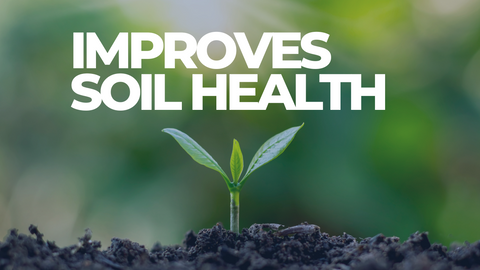 1. Wool pellets hold 3 times their weight in water to reduce how frequently you need to water and keep your soil from drying out so quickly, especially in those hot summer months and starting seeds indoors. Lanolin is the natural oil that sheep produce that coats the wool fiber, this oil is what helps keep the water in the wool pellet until the plant is ready to use it, then the wool releases the water to the plant.
1. Wool pellets hold 3 times their weight in water to reduce how frequently you need to water and keep your soil from drying out so quickly, especially in those hot summer months and starting seeds indoors. Lanolin is the natural oil that sheep produce that coats the wool fiber, this oil is what helps keep the water in the wool pellet until the plant is ready to use it, then the wool releases the water to the plant.

2. Wool pellets slowly release nitrogen, potassium, and other micronutrients for plant growth and health. The release curve of these nutrients is fairly constant meaning that wool pellets start releasing nutrients right away and continue to do so as they biodegrade over the course of 6 months. To view our nutrient analysis, click here.

3. Wool pellets biodegrade in about 6 months, continuously releasing nutrients. Since our wool pellets are made of 100% sheep wool, they naturally biodegrade in the soil.

4. Wool pellets increase soil porosity. They expand and contract with moistures, so when they eventually biodegrade in the soil, they create air pockets which increases the oxygen and nutrient uptake to the plant roots.

5. Wool pellets support American sheep producers. In addition to using wool from our own sheep flock, we work with a sheep shearing crew right down the road from us. By sourcing local wool, we are able to reduce our carbon footprint due to transportation and ensure money stays in the surrounding rural economies.

6. Wool pellets repel slugs. An individual fiber of wool has a barb-like structure (it looks like fish scales overlapping) which slugs hate to crawl across. To repel slugs, mulch a 6-inch radius around your tasty plants with wool pellets, water, and it will create a mat of wool that the slugs don't like. I've gotten feedback that this method helps keep squirrels out of your garden too!

7. Wool pellets are eco-friendly. Wool pellets are made from a natural and renewable, yet underutilized resource, sheep wool. As mentioned above, sourcing local wool reduces our carbon footprint associated with transportation. We also use compostable packaging to keep our product as sustainable as possible. View our sustainability mission here.

8. Wool pellets positively impact your soil health. By incorporating wool into the soil, you're completing the carbon cycle that begins as sheep continuously and naturally grow wool as they harvest sunlight and forages. They add much need organic material into the soil. Let's work with nature to nourish your soil!

9. Wool pellets are safe for the whole family including ones of the four-legged variety. Our wool pellets are all-natural and made from 100% sheep wool. Pets (especially dogs) may be attracted to the smell of wool pellets, but once the wool pellets are mixed in with the soil, the smell is not noticeable. While we don’t suggest you let your pets consume wool pellets, they present no inherent danger in proximity to your furry family members!

10. Wool pellets are easy to apply. You don't need a ton of wool pellets to make a difference in your harvest. For optimum results, you only need 2-5% of the soil volume to be wool pellets. This equates to about 1/2 cup per gallon of soil or about 1 pound per 10 sq. ft. of garden. Just mix the recommended amount of wool pellets into your soil and let the wool work its magic!
Feel free to contact us if you have any questions or visit our FAQs page. You can purchase wool pellets on our website. We are able to ship anywhere in the US.
Happy gardening, friends!
Megan ❤


3 comments
Thank you so much for the kind words, we’re happy you’re enjoying the benefits of wool pellets!
I just wanted to say that using your wool pellets in my window boxes has worked out beautifully! I have not had to remove the screens in my windows once to water the ivy that I plant in them each Spring. The plants are thriving and I haven’t done a thing for them all Spring and Summer. My husband was so impressed with how well the pellets have worked that we plan to make sure to incorporate your pellets in all of our new planting, both potted and in our yard, next Spring.
My wife and I bought a pound of your wool pellets yesterday at the Canby Spring Garden Show. We’re anxious to give it a try. My seed starts in my little greenhouse dry out too quickly. That’s one way I’ll be using the pellets. If your pellets work as well as the research and your website state, I’ll be contacting you to buy more. Thanks for your work is this area.